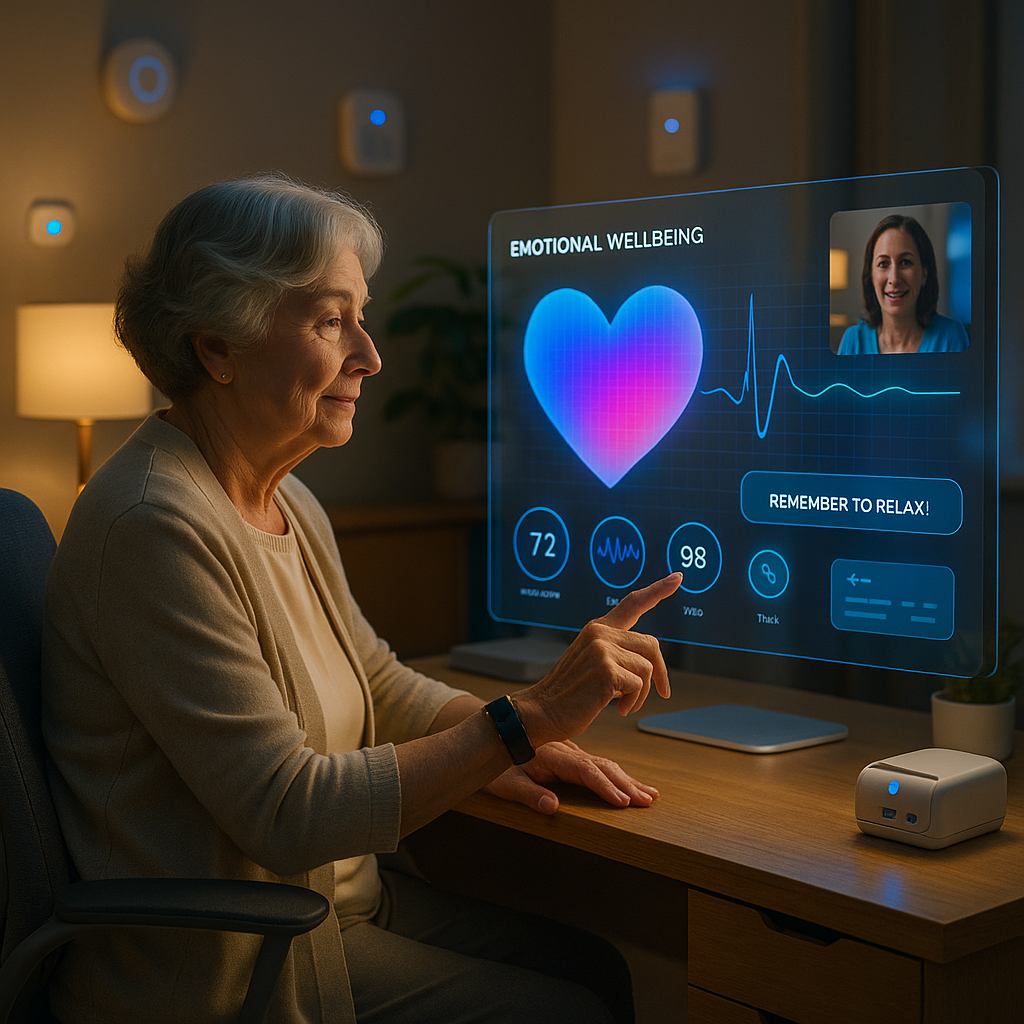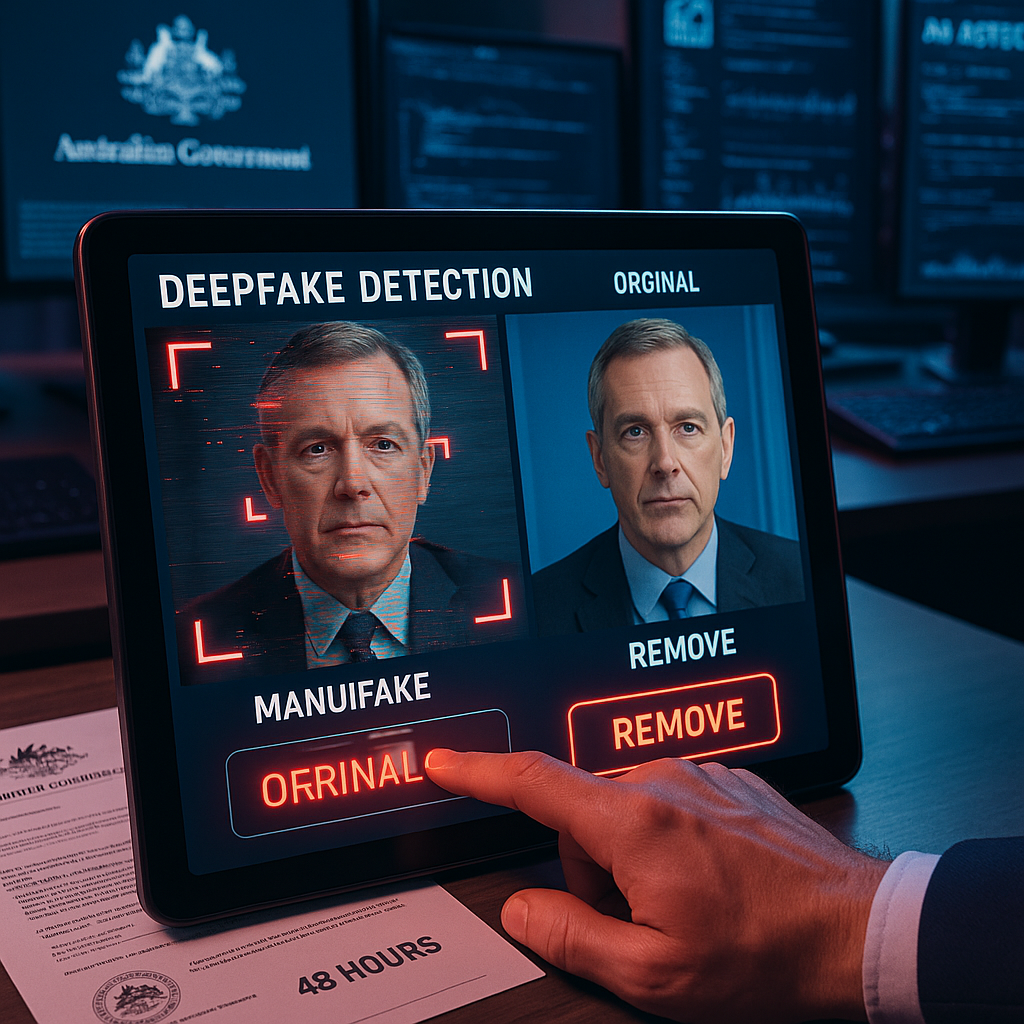Key Takeaways
-
Workplace AI systems are advancing well beyond traditional employee wellness platforms. They are now harnessing real-time data to detect stress and intervene before psychological decline or burnout occurs. This article explores how the sophisticated stress monitoring technologies found in modern workplaces can be thoughtfully adapted to support seniors, helping bridge the gap between corporate wellness and elder care to promote independent, dignified aging.
-
AI is evolving from a workplace guardian into a vital ally for seniors. The stress detection algorithms protecting employees from burnout are now being repurposed to monitor the mental health of older adults, providing early identification of anxiety, depression, or cognitive decline.
-
Continuous monitoring through AI enables proactive, preventative interventions. By tracking behavioral and physiological shifts around the clock, these systems can identify issues before they escalate, facilitating timely responses from caregivers, clinicians, or loved ones and reducing the frequency of crisis events.
-
Human-AI partnerships are amplifying support networks. Integrating AI-driven insights with compassionate human supervision ensures seniors benefit from a blend of high-tech monitoring and authentic, empathetic engagement. This fusion enhances trust and addresses the complex emotional needs that technology alone cannot satisfy.
-
Privacy and ethics demand robust, transparent safeguards. As AI systems gain access to ever more personal realms (especially among vulnerable populations), upholding transparency, informed consent, and rigorous data protection protocols becomes foundational to ethical adoption.
-
Design for dignity: user-friendly, non-intimidating interfaces are essential. To drive senior adoption, AI tools must be intuitive, accessible, and sensitive to age-related barriers, reducing stigma and technological anxiety.
-
An overlooked opportunity emerges when transferring proven workplace AI wellness strategies into the home setting. By repurposing these systems, elders at home can receive the same level of mental health protection now considered mission-critical in the corporate world.
This article invites you to look beyond the corporate setting and consider a future where technology empowers seniors to live independently, supported by the very innovations that are reshaping the modern workplace. Let’s examine the mechanics, practical adaptations, and ethical considerations of this transformative convergence.
Introduction
Stress detection algorithms that once shielded busy executives from burnout in boardrooms are quietly finding a new, compassionate frontier: the homes of seniors who value independence and dignity. AI-driven mental health systems (originally engineered to catch subtle emotional signals before a workforce reaches crisis mode) are now being purposefully reimagined to safeguard the psychological well-being of elders. With these systems, early indicators of anxiety, depression, or cognitive changes can be detected, often long before such issues escalate into more severe health challenges.
But this is about more than just clever programming and sensor technology. It’s a story of partnership between human caregivers and AI, about crafting solutions that are both proactive and deeply empathetic. As we explore the promise and complexity of adapting industrial-strength wellness monitoring for home environments, a new challenge emerges: leveraging data-driven tools to enhance well-being while fiercely defending privacy, autonomy, and trust. This article explores how the thoughtful integration of continuous AI monitoring with nuanced human oversight can transform mental health support for seniors, heralding an era where technology becomes a guardian of dignity and independence, never a replacement for genuine human care.
Evolution of Workplace AI Mental Health Monitoring
The journey of AI-driven mental health monitoring in the workplace is a story of rapid, multifaceted transformation. A little over a decade ago, the landscape consisted mostly of simple fitness trackers and pulse-reading devices—tools that offered fragmentary glimpses into employee well-being. Today, these early efforts have given way to rich, multi-modal ecosystems that blend physiological measurement, behavioral analytics, and even emotional interpretation.
Stay Sharp. Stay Ahead.
Join our Telegram Channel for exclusive content, real insights,
engage with us and other members and get access to
insider updates, early news and top insights.
 Join the Channel
Join the Channel
A 2022 Deloitte survey found that 64% of Fortune 500 companies now implement some form of AI-powered employee well-being initiative. This illustrates not just technological progress, but a shifting corporate mindset: mental health has become as much a business imperative as financial performance.
Technical Foundations of Current Systems
Modern workplace AI mental health monitoring operates on multiple, interconnected layers:
- Physiological Metrics: The latest biosensors can continuously track heart rate variability (HRV), skin conductance (GSR), and even cortisol levels using non-invasive techniques. For example, HRV has been shown to have a 78% correlation with self-reported stress among office workers, making it one of the industry’s most reliable stress biomarkers.
- Behavioral Analytics: Powerful algorithms sift through digital behavioral footprints: typing cadence, email traffic after hours, patterns of meeting attendance, and software usage data. Microsoft’s Workplace Analytics exemplifies this approach, processing over 100 discrete behavioral signals to detect patterns linked to burnout risk.
- Natural Language Processing (NLP): AI-driven sentiment analysis tools now examine everything from internal chat messages to email subject lines (always with privacy safeguards in place). Research demonstrates that shifts in pronoun use and emotional word frequency can predict stress-related leave with notable accuracy, sometimes up to three weeks in advance.
- Computer Vision: In certain advanced platforms, video analytics detect minute changes in facial expression during virtual meetings, identifying subtle, often overlooked signs of emotional strain. In controlled settings, accuracy rates for detecting severe emotional distress can approach 85%; however, these systems remain contentious due to privacy concerns.
When systems combine these inputs, they produce a nuanced, dynamic portrait of both individual and collective mental states within organizations. This holistic approach forms the backbone of a $3.8 billion global market for AI-driven employee wellness technology, a sector that has expanded at nearly 28% per year since 2019.
From Reactive to Predictive Systems
Perhaps the most important shift has been the transition from reactive monitoring to predictive intervention. No longer limited to spotting current stress, these tools can now forecast future mental health risks, alerting both employees and support teams before issues explode into absenteeism or disengagement.
Key predictive methods include:
- Longitudinal Baseline Analysis: Instead of comparing data to generic averages, modern systems learn what’s normal for each individual and flag unusual deviations.
- Contextual Data Integration: Stress signals are analyzed against broader organizational data: looming project deadlines, departmental restructures, or recent layoffs that can raise baseline anxiety.
- Adaptive Machine Learning Models: By tracking which interventions successfully ameliorate stress for different user profiles, algorithms recalibrate their recommendations, growing smarter with every cycle.
This forward-looking approach is proving invaluable. It delivers a blueprint that’s especially promising for senior care, where anticipating and intervening in mental health struggles can make the difference between thriving for years at home and needing acute, institutional care.
Adapting Workplace AI Technologies for Senior Care
Adapting workplace-scale monitoring for seniors is much more than transplanting software. It demands careful attention to the distinct physiological, social, and emotional realities of aging. This requires both technological recalibration and clinical awareness.
Technical Adaptation Requirements
Translating these AI systems from bustling offices to the varied rhythms of seniors’ lives comes with unique challenges:
- Sensor Redesign: The wearables and environmental sensors used in corporate settings were built for active, tech-savvy workers. For seniors, companies like Empatica and CarePredict are developing ruggedized devices with simple controls and longer battery lives. These new designs prioritize comfort, accessibility, and unobtrusive monitoring.
- Baseline Recalibration: Age brings inherent changes in physiology. Algorithms initially trained on adults in midlife must be finely retuned. For instance, HRV thresholds signaling stress in young corporate employees may fail to capture risk in an 80-year-old retiree, whose baseline HRV is naturally lower. Researchers have shown recalibration for age can improve detection success in seniors by as much as 32%.
- Environmental Context Shifting: In workplaces, stressors are project milestones and meetings. For seniors, context includes medication schedules, therapy appointments, and social visits. Systems must integrate these signals for meaningful, scenario-specific interpretation.
- Seamless Health System Integration: Unlike standalone corporate tools, senior-focused solutions must communicate securely with electronic health records, alert emergency response networks, and inform remote caregivers or clinicians when issues arise. Developing reliable, standardized data protocols is crucial to smooth, secure coordination.
Addressing Senior-Specific Mental Health Concerns
Seniors present unique mental health challenges, many distinct from those seen in working adults. The most effective AI systems reorient their focus to target these situations:
- Social Isolation Detection: Whereas workplace tools flag symptoms of burnout due to over-engagement, elder care platforms must watch for growing detachment: fewer phone calls, abrupt withdrawal from favorite activities, or dwindling interaction with family and friends.
- Cognitive Change Alertness: Early-stage cognitive decline often manifests subtly: misplaced items, unusual payment patterns, or confusion with medications. Companies like Winterlight Labs have pioneered the adaptation of workplace NLP tools for home dementia screening, surfacing changes in speech or thought patterns before families notice them in daily interactions.
- Depression and Grief Recognition: Late-life depression is common but underdiagnosed, often masked by physical complaints or mistaken for normal aging. Tailored AI models track changes in sleep, appetite, and communication style to spot the early signs, enabling swift mental health outreach.
- Medication Adherence Monitoring: Mental health struggles often disrupt medication routines. Integrating mood-tracking data with pill management reminders allows systems to gently flag lapses, prompting timely support that can prevent cascading health crises.
Promising results are emerging. For example, Providence Health’s deployment of adapted stress monitoring systems in senior living environments increased early detection of depression by 47% and reduced emergency mental health events by 28% over an 18-month trial. These initiatives illustrate the far-reaching advantages of technology migration when grounded in thoughtful, needs-driven adaptation.
In addition to healthcare, these AI-driven adaptations are influencing fields like finance (where monitoring decision changes can flag cognitive decline), education (supporting lifelong learning by adapting to cognitive shifts), and consumer product design (creating user-friendly, senior-centric technology interfaces).
Ethics and Privacy Considerations in AI Monitoring for Seniors
Transferring AI wellness monitoring from workplaces to the deeply personal spaces of older adults brings ethical complexity to the forefront. While early detection and intervention can save lives, the risk of overreach (eroding autonomy, privacy, or dignity) grows if transparency does not anchor every innovation.
Balancing Surveillance with Autonomy
Supporting seniors effectively means navigating a fine line:
- Consent Complexity: Consent must move beyond a one-time checkbox. For seniors, especially those facing cognitive changes, ongoing, dynamic consent models are essential. Some care facilities now perform regular cognitive assessments to recalibrate monitoring permissions, ensuring that participation remains informed and voluntary.
- Graduated, Individualized Monitoring: Not all situations demand the same level of scrutiny. Leading-edge systems now employ adaptive monitoring, escalating only when specific behavioral changes or risk thresholds are detected. For example, Sunrise Senior Living’s AI-based system starts with low-impact monitoring and increases only if worrisome signs arise, preserving a sense of personal space and respect.
- Ensuring Privacy Zones: True dignity rests on the ability to maintain private moments. The best systems offer daily “monitoring-free” periods or explicitly protected rooms within the home, approaches that 83% of seniors say increase their willingness to use technology.
Data Ownership and Control
Questions of who controls sensitive mental health data become even more complex in senior care:
- Multi-Stakeholder Access: Whereas employers traditionally own workplace data, information gathered from elderly individuals may need to be shared with family, healthcare providers, and professional caregivers. Clear, transparent frameworks define who can view, edit, and delete records, preventing misuse while ensuring critical interventions are never delayed.
- Right to Delete and Limit Use: Seniors should have the right to delete their personal data, especially when it is no longer needed for active care. Provisions for purging data protect autonomy and reinforce the deeply personal nature of mental health information. Secondary uses, such as insurance profiling or targeted advertising, must be explicitly prohibited beyond the boundaries of direct service provision.
Addressing Algorithmic Bias and Inclusion
AI systems trained on workplace data are susceptible to misleading conclusions if not adjusted for age or cultural background:
- Age-Related Corrections: What appears anomalous for a 35-year-old may be entirely normal in the context of the oldest old. Ethical implementations require that AI models be retrained on diverse, senior-specific datasets, and regularly audited for fairness.
- Cultural Sensitivity: Patterns of expressing distress or seeking help can vary dramatically across cultures and generations. Effective systems embed cultural and generational awareness, reducing false alarms and ensuring all seniors (regardless of background) benefit equally.
- Bridging the Digital Divide: Technological progress must not widen inequality. Solutions must be priced and designed for accessibility, ensuring that all seniors, not only the most affluent or tech-literate, gain from these advances.
The ethical blueprint outlined by organizations such as the Aging Technology Consortium prioritizes these principles: supplementing human care (never replacing it), centering on senior preferences, and engaging in regular ethical review. These standards can help ensure AI is used not as a blunt instrument, but as a nuanced partner supporting healthier, more autonomous aging.
Stay Sharp. Stay Ahead.
Join our Telegram Channel for exclusive content, real insights,
engage with us and other members and get access to
insider updates, early news and top insights.
 Join the Channel
Join the Channel
Beyond elder care, these ethical questions are echoed in sectors like healthcare policy, legal compliance, and consumer advocacy, as AI expands into new domains and touches ever more lives.
Conclusion
The journey of mental health AI from the fast-paced world of commerce to the intimate reality of senior living marks a pivotal evolution in both technology and societal values. As these systems transition from boosting productivity to nurturing dignity, their greatest impact will hinge on thoughtful adaptation: recalibrating sensors and algorithms to suit older bodies and minds, embedding diversity and ethical privacy by design, and deeply respecting the complex, emotional landscape of aging.
Yet, realizing this promise requires more than technical ingenuity. It calls for a sustained, inclusive conversation between inventors, caregivers, and seniors themselves—a dialogue that grounds AI in values of trust, transparency, and genuine empowerment. This confluence of human and digital insight is not a mere transplant from boardrooms to living rooms, but the invention of an entirely new paradigm: one in which technology amplifies connection, safeguards independence, and redefines what it means to age well.
Looking ahead, those willing to invest in privacy-centric, adaptive, and empathetic AI solutions will shape the future not only of elder care, but of how we care for all people in an AI-augmented society. The challenge is no longer simply how to migrate technology, but how to envision a future where every stage of life benefits from the alliance of human wisdom and “alien minds.” Will we rise to this occasion, creating systems that enhance both autonomy and compassion in the digital age? The decisions we make now will echo long beyond today, influencing the dignity, safety, and fulfillment of generations to come.




Leave a Reply